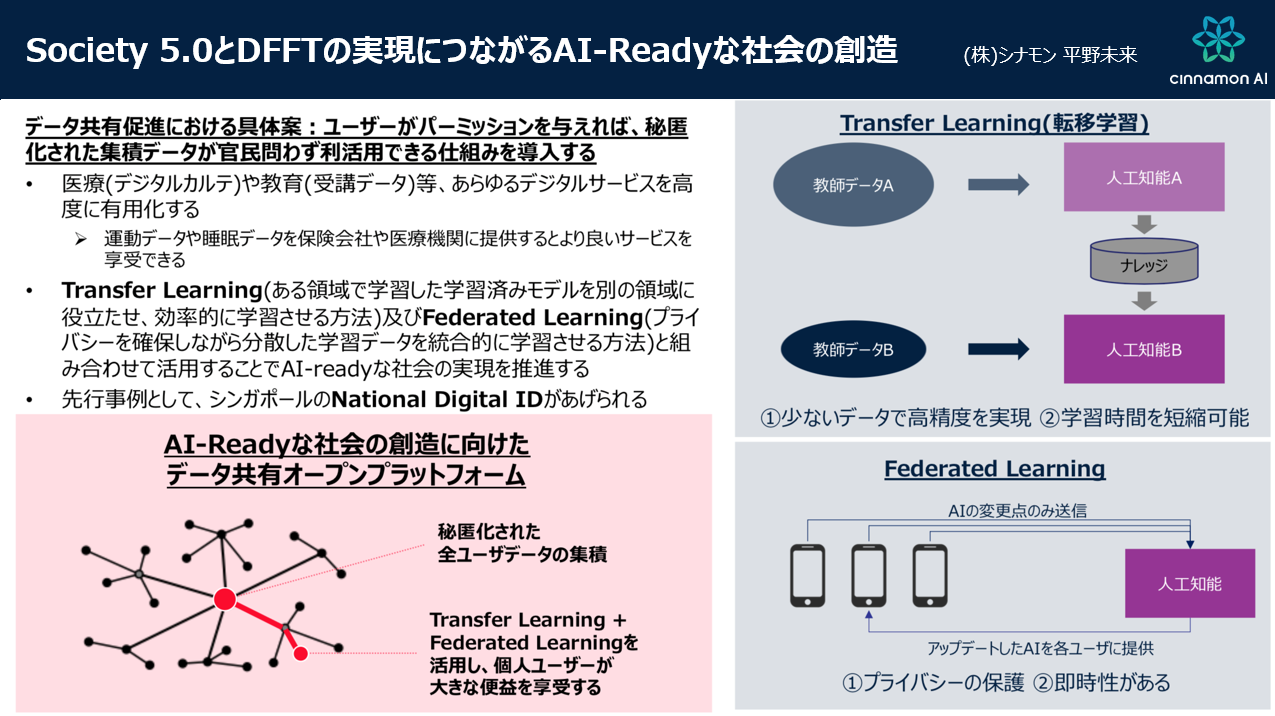
blog cinnamon blog

- management
What is needed now to create an “AI-Ready” society

What is DFFT proposed by the Japanese government?

"DFFT (Data Free Flow with Trust)" was proposed by the Japanese government at last year's Davos Conference. This is the basic concept that data should be distributed more freely while ensuring reliability in order to realize Society 5.0.
Europe, a leading country, has already established a policy called GDPR (General Data Protection Regulation) to promote the management, protection and utilization of personal data, and Japan is following suit and steadily moving towards a smart society. We are making progress.
In order to make effective use of AI, of course, we need the underlying data. In other words, as AI becomes more and more integrated into society, data will become an important source of competitiveness. However, data that is particularly linked to personal information is not collected in an open place to begin with, nor is it managed with the assumption that it will be used.
Therefore, the underlying idea of DFFT is to create an AI-Ready state where AI can be used effectively and safely.
However, in Japan, where people are highly allergic to the disclosure of personal information, the reality is that many people oppose the free flow of data. There are probably a lot of concerns about security.
Therefore, instead of aiming to build a large-scale AI model from the beginning, there is an idea that we should create a small AI model that utilizes data locally.
What is small AI? For example, this refers to a learning model that operates only in a certain class at a certain junior high school, or a learning model that operates only within a specific hospital or EC service. Since there is no general-purpose data available in the world, we should start by creating a large amount of such local AI.
However, even when building this small AI model, there are likely to be various barriers to gaining user consent. Therefore, this time I would like to consider two methods: Federated Learning and Transfer Learning.
Two methods hold the key to realizing DFFT
 *Cabinet Secretariat IT Comprehensive Strategy Headquarters Conference Submission Materials
*Cabinet Secretariat IT Comprehensive Strategy Headquarters Conference Submission Materials
First of all, Federated Learning is a method of learning distributed learning data in an integrated manner while ensuring privacy. The most familiar example is "Gboard," Google's virtual keyboard app installed on smartphones.
"Gboard" is a multilingual keyboard app that is highly convenient for character input, such as supporting "glide input" that can be used by tracing the dial, and I personally use it a lot on a daily basis. The real point is not actually in the text input, but in the fact that the AI is running in the background.
Gboard works with Google's cloud to learn each user's conversion characteristics and frequently used words. Therefore, a major feature is that the more you use it, the more it is customized to suit the user's personality.
This is small AI for each smartphone, and it is a federated learning model in which the data learned on each smartphone device is integrated on the cloud and fed back to each device.
What is important here is that the data uploaded to the cloud only shows usage trends, and does not include the words or content entered, nor any personal information of the user. This model, in which information is kept confidential and collected centrally, can be said to be a method that is easy to accept even for Japanese people who are sensitive to personal information protection.
On the other hand, Transfer Learning refers to transfer learning, which refers to a method of transferring a trained model in one domain to another domain for efficient learning.
AI inherently requires large amounts of medical data when used for medical care, and educational data when used for education. However, one barrier is how to procure that data. Therefore, the Transfer Learning method customizes medical data and repurposes it into an educational model, making it possible to learn efficiently with limited data.
For example, an easy-to-understand example would be a model like the service we provide, in which information such as address and name read using OCR from a driver's license is transferred directly to the sender field of the bill. It goes without saying that reusing a single piece of data is more efficient than developing separate AI for reading driver's licenses and AI for reading invoices.
When this Transfer Learning method is applied, it can be used in a variety of ways, such as transferring mathematics test data to Japanese language subjects within a school, or transferring data of current students to medical institutions in the city via a central server. It will continue to spread.
In Singapore, the use of National Digital ID is actually being promoted by users granting permission, making it easier to provide government services. In the future, an era may come when biometric data collected from smartwatches will be transferred to medical institutions via the cloud, allowing them to receive more appropriate medical treatment and receiving more appropriate product recommendations from insurance companies. I don't know. Technically, it is still quite possible.
If things go even further, it will be possible to link e-commerce sites and individuals' credit, allowing them to borrow the necessary amount on the spot when purchasing something they want. If the accumulated data can be used by both the public and private sectors, society's convenience will be greatly improved depending on the ideas.
Aiming for an AI-ready society

However, in each case, the key is the reliability of the data flow. If users do not trust and give permission to provide data, they will not be able to utilize the accumulated data that exists and will end up losing it. At this rate, the realization of a smart society is still a pipe dream.
The solution to this problem is technology, and when it comes to privacy issues, it is thought that most of them can be solved using the Federated Learning model mentioned earlier. The challenge going forward will be how far the usefulness of DFFT can be communicated to the public under the concept of DFFT that the government has proposed.
Society 5.0 aims for ideal collaboration between cyberspace and physical space by making full use of IoT. How will our lives change in the resulting smart society?
For example, when visiting a company, you may be able to access the desired floor directly without having to go through the formalities at the reception desk as before. Alternatively, a service may be created where the items you want are displayed one after another on a display in front of you the moment you enter an apparel store.
Creating an AI-ready society that is compatible with such a world is the first step toward Society 5.0.
 Cinnamon AI President and CEO Mirai Hirano Serial Entrepreneur. Completed graduate school at the University of Tokyo. Engaged in research on recommendation engines, complex networks, clustering, etc. It was twice selected for the IPA Unexplored Software Creation Project in 2005 and 2006. Founded Naked Technology while still in school. We develop and operate middleware that allows you to develop applications on IOS/ANDROID/flip phones. In 2011, the company was sold to Mixi. Received various domestic and international awards such as ST.GALLEN SYMPOSIUM LEADERS OF TOMORROW, FORBES JAPAN “Entrepreneur Ranking 2020” BEST10, Woman of the Year 2019 Innovative Entrepreneur Award, VEUVE CLICQUOT BUSINESS WOMAN AWARD 2019 NEW GENERATION AWARD . He has also given a keynote speech at AWS SUMMIT 2019, Milken Institute Japan Symposium, 45th Japan-ASEAN Management Conference, Bloomberg THE YEAR AHEAD Summit 2019, etc. Since 2020, he has been appointed as a member of the Cabinet Secretariat IT Strategy Office and a special member of the Cabinet Office Tax Investigation Committee. From 2021, he will serve as an expert member of the Cabinet Office's Economic and Fiscal Policy Council. In her private life, she is a mother of two children. Cinnamon AI President and CEO Mirai Hirano Serial Entrepreneur. Completed graduate school at the University of Tokyo. Engaged in research on recommendation engines, complex networks, clustering, etc. It was twice selected for the IPA Unexplored Software Creation Project in 2005 and 2006. Founded Naked Technology while still in school. We develop and operate middleware that allows you to develop applications on IOS/ANDROID/flip phones. In 2011, the company was sold to Mixi. Received various domestic and international awards such as ST.GALLEN SYMPOSIUM LEADERS OF TOMORROW, FORBES JAPAN “Entrepreneur Ranking 2020” BEST10, Woman of the Year 2019 Innovative Entrepreneur Award, VEUVE CLICQUOT BUSINESS WOMAN AWARD 2019 NEW GENERATION AWARD . He has also given a keynote speech at AWS SUMMIT 2019, Milken Institute Japan Symposium, 45th Japan-ASEAN Management Conference, Bloomberg THE YEAR AHEAD Summit 2019, etc. Since 2020, he has been appointed as a member of the Cabinet Secretariat IT Strategy Office and a special member of the Cabinet Office Tax Investigation Committee. From 2021, he will serve as an expert member of the Cabinet Office's Economic and Fiscal Policy Council. In her private life, she is a mother of two children. |
At Cinnamon AI, we help you connect AI to your competitive strategy through consulting, workshops, and solutions. We would appreciate it if you could feel free to contact us.
Click here to contact us => Inquiry form
Recommended articles
-
 management
management -
 management
managementPurpose formulation and harvest loop based on customer experience
Purpose formulation and harvest loop based on customer experience
-
 management
managementThe concept of “Expert-in-the-Loop” where humans and AI work together
The concept of “Expert-in-the-Loop” where humans and AI work together
